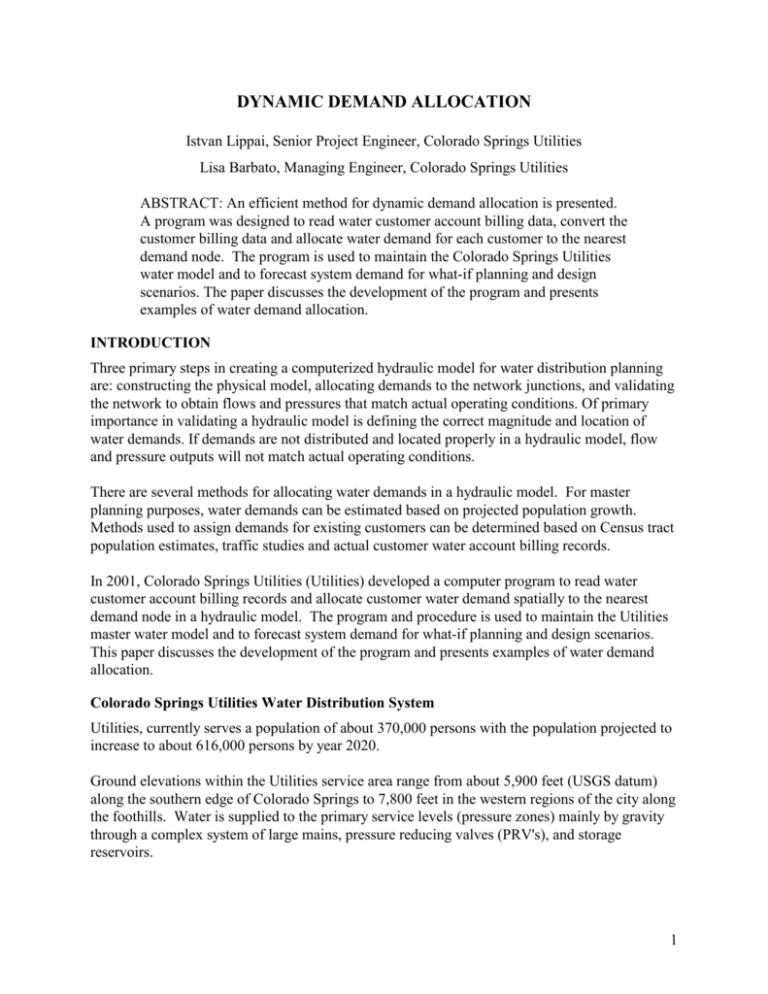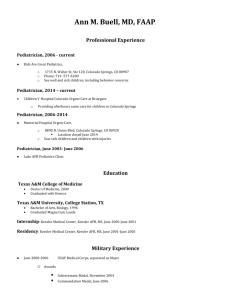Dynamic Demand Allocation
advertisement

DYNAMIC DEMAND ALLOCATION Istvan Lippai, Senior Project Engineer, Colorado Springs Utilities Lisa Barbato, Managing Engineer, Colorado Springs Utilities ABSTRACT: An efficient method for dynamic demand allocation is presented. A program was designed to read water customer account billing data, convert the customer billing data and allocate water demand for each customer to the nearest demand node. The program is used to maintain the Colorado Springs Utilities water model and to forecast system demand for what-if planning and design scenarios. The paper discusses the development of the program and presents examples of water demand allocation. INTRODUCTION Three primary steps in creating a computerized hydraulic model for water distribution planning are: constructing the physical model, allocating demands to the network junctions, and validating the network to obtain flows and pressures that match actual operating conditions. Of primary importance in validating a hydraulic model is defining the correct magnitude and location of water demands. If demands are not distributed and located properly in a hydraulic model, flow and pressure outputs will not match actual operating conditions. There are several methods for allocating water demands in a hydraulic model. For master planning purposes, water demands can be estimated based on projected population growth. Methods used to assign demands for existing customers can be determined based on Census tract population estimates, traffic studies and actual customer water account billing records. In 2001, Colorado Springs Utilities (Utilities) developed a computer program to read water customer account billing records and allocate customer water demand spatially to the nearest demand node in a hydraulic model. The program and procedure is used to maintain the Utilities master water model and to forecast system demand for what-if planning and design scenarios. This paper discusses the development of the program and presents examples of water demand allocation. Colorado Springs Utilities Water Distribution System Utilities, currently serves a population of about 370,000 persons with the population projected to increase to about 616,000 persons by year 2020. Ground elevations within the Utilities service area range from about 5,900 feet (USGS datum) along the southern edge of Colorado Springs to 7,800 feet in the western regions of the city along the foothills. Water is supplied to the primary service levels (pressure zones) mainly by gravity through a complex system of large mains, pressure reducing valves (PRV's), and storage reservoirs. 1 The Utilities service area is divided into five major service levels including Briargate, Templeton, Northfield, Highline, and Lowline (Figure 1). Ten secondary service levels are served within each primary service level. Four water treatment plants provide a total delivery capacity of 230 million gallons per day (MGD). Water treatment plants are McCullough (75 MGD), Pine Valley (92 MGD), Mesa (50 MGD), and Fountain Valley Authority (FVA, 13 MGD). McCullough (75) Pine Valley (92) BRIARGATE NORTHFIELD TEMPLETON Mesa (50) HIGHLINE LOWLINE FVA (13) Figure 1- Colorado Springs Utilities Water Distribution System Major Pressure Zones and Water Treatment Plants WATER DISTRIBUTION SYSTEM MASTER PLAN AND MODEL Black & Veatch developed a Water Distribution System Master Plan (Master Plan) for Utilities in 1999. The Master Plan describes the existing system components as well as identifies major short and long-term infrastructure improvements. Infrastructure improvements were identified using the hydraulic software, H2Onet (MW Soft, 2002). The Utilities H2Onet model included all pipes 12-inch and larger and 8-inch pipes to complete loops and simulate secondary service levels (pressure zones). The Model included 1,434 pipes, 87 valves (PRV's and control valves), and 62 pumps (Figure 2). 2 Figure 2- Colorado Springs Utilities 1999 H2Onet Model DYNAMIC DEMAND ALLOCATION PROGRAM At the present time, Utilities relies on water distribution modeling for long and short term planning, new development planning, fire flow determinations and operational predictions. An important requirement for realistic water distribution system modeling is an accurate determination of system demand. The addition of new developments and the modeling of hydrant discharge capacities are increasing the links and junctions in the Model. Currently the Model has over 13,000 links and over 10,000 junctions (Figure 3) and growing rapidly. The original demand allocation was no longer acceptable for the changed and greatly expanded Model. A water demand allocation program was developed to link the Model with the Utilities customer account records of annual water billing data. For each account, the customer number, total annual water use in cubic feet, latitude and longitude was saved to a text file (Figure 4). In 2000, 110,765 customers used an average of 69.32 MGD. In 2001, 113,953 customers used an average of 69.99 MGD. In 2002, 117,622 customers used an average of 64.94 MGD. The 2002 average customer demand of 64.94 MGD was adjusted to a design demand of 84 MGD to account for system losses. The text file of customer use records is updated annually. 3 Figure 3- Colorado Springs Utilities 2003 H2Onet Model Description of Dynamic Demand Allocation Program H2ONet organizes input data in spreadsheet format. The H2ONet Junction Demand table is copied and pasted into the Junction Demand worksheet (Figure 5). The H2ONet Junction Information table is copied and pasted into the Junction Information worksheet (Figure 6). The H2ONet Node Geometry table is copied and pasted into the Node Geometry worksheet (Figure 7). The program, WinCSU.EXE, developed with Windows C++, organizes the information from the worksheets into arrays. Worksheet of Junction Demands is for arrays ID, DEMAND1 and PATTERN1 , worksheet of Junction Information is for array DESCRIPT, and worksheet of Node Geometry is for arrays for X and Y. The array for DESCRIPT serves to identify junctions with no demand or junctions with special demand. The Demand Solver worksheet (Figure 8) defines the user options. The most significant user option is the targeted demand (Cell B5). The targeted demand allows the mapping of actual demand to the target design demand. The year 2002 water billing records based average daily demand of 64.94 MGD is be mapped into the system as 84.00 MGD design average daily demand for 2002. 4 Figure 4– Text File of Customer Water Use Records Figure 5 – Junction Demand from H2ONet Data Base 5 Figure 6 – Junction Information from H2ONet Data Base Figure 7 – Node Geometry from H2ONet Data Base 6 Figure 8 – Demand Allocation Setup Screen The demand allocation program is activated by clicking on Cell B4 and pressing Enter, activating the link_WinPipes function. link_WinPipes sets up the arrays and calls WinCSU.EXE. WinCSU.EXE reads each line of customer records, converts the longitude and latitude of each account to user X and Y coordinates, finds the junction closest to the customer and allocates the customer use to the closest junction. It takes about two minutes to process 115,589 accounts. If the run is successful, the total system demand is returned to Cell B4. If no trace files are requested (trace files were used to help program development) the run will produce three text files, SUMMARY.ZN1, SUMMARY.ZN2 and REPLACE.ALL. The summary files show the distribution of demand by zones before and after adjusting for target demand. The REPLACE.ALL file contains each demand junction with new demand and pattern (Figure 9). Transfer the contents of this file to H2ONet Junction Demand data base completes the demand allocation. The complete process takes less than 15 minutes. DEMAND ALLOCATION PROGRAM APPLICATION Mapping customer account records to the closest junction in H2ONet provides for quick and accurate update of system demands. Utilities provide fire flow reports for existing hydrants. Getting a realistic estimate of fire flow requires adding a large number of existing pipes and junctions to the Model. Redistributing system demands after the addition of 200-300 junction nodes maintains a realistic demand distribution in the Model and improves model convergence. 7 Figure 9 – New Demands Based on Customer Use Records Most of the growth is predicted to occur in the Briargate and Templeton zones (Figure 1). Assigning the predicted demand increase to these pressure zones and allocating the demand was used for exploring what-if scenarios for system expansion and operation. ACKNOWLEDGEMENT The authors thank Colorado Springs Utilities for supporting this project. Special thanks to Pat Hamburger, Applications Senior and Lu Ann Maddy, Applications Specialist with Colorado Springs Utilities for producing customer water use records. REFERENCES Black and Veatch Corporation, 1999. Colorado Springs Utilities, Water Distribution System Master Plan. MW Soft, Inc., 2002. H2Onet, Graphical Water Distribution Modeling and Management Package. 8







